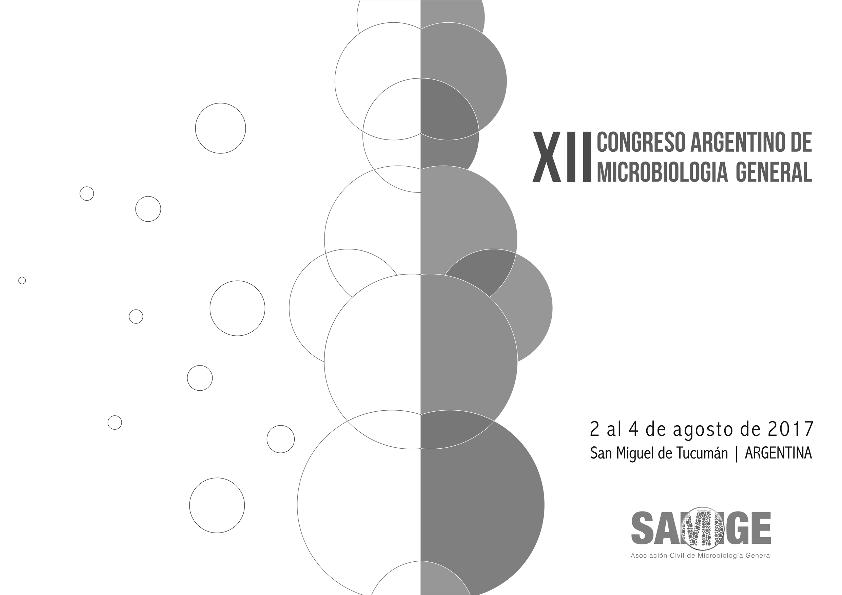Mostrar el registro sencillo del ítem
dc.contributor.author
Ordoñez, Omar Federico

dc.contributor.author
Soria, Mariana Noelia

dc.contributor.author
Rasuk, Maria Cecilia

dc.contributor.author
Farias, Maria Eugenia

dc.date.available
2023-02-22T16:36:26Z
dc.date.issued
2017
dc.identifier.citation
Haloarchaea from the Andean Puna: biological role in the energy metabolism of arsenic; XII Congreso Argentino de Microbiología General; San Miguel de Tucumán; Argentina; 2017; 1-2
dc.identifier.uri
http://hdl.handle.net/11336/188604
dc.description.abstract
Arsenic metabolism is proposed to be an ancient mechanism in microbial life. In fact, some Bacteria andArchaea are able to exploit arsenic as a bioenergetic substrate in either anaerobic arsenate respirationor chemolithotrophic growth on arsenite as an electron donor. The high-altitude Andean lakes (HAAL)consist of several shallow lakes located in a high-altitude desert known as Puna, and these placed aredistributed through Argentina, Chile, Bolivia, and Peru along the Central Andes region in South America.This environment host unexplored ecosystems of shallow lakes and salt flats at altitudes of 3700 metersabove sea level (masl). In these places high concentrations of arsenic were found in the water andthese was attributed to the high Andean volcanism phenomenon which provides the geoenvironmentalconditions and determine the availability of arsenic. Recently, our group has reported a metagenomicsanalysis of a microbialite from Diamante Lake, Catamarca, which was widely dominated by Archaea(96%), assigned to the class Halobacteria (commonly called as haloarchaea). Moreover, these authorsstrongly suggest that the prevalent haloarchaeal part of the biofilm have all the genes necessary for anaerobicarsenate respiration and arsenite oxidation, suggesting that these haloarchaea use arsenic compoundsas bioenergetics substrates to sustain growth. The objective of our study was to investigate thepresence and expression of genes (aioA and arrA) involved in obtaining energy from arsenic compoundsin environmental samples and isolated strains. The effect of As [V] and As [III] during isolates growth andthe possible role of As as bioenergetic substrate in two selected strains was also evaluated. The presenceof aioA and arrA genes was confirmed in total community DNA from Diamante and Tebenquiche lakes,and the expression of these genes was confirmed by metatranscriptomic RNA samples, suggesting anactive expression of both genes in the studied samples. Using selective isolation techniques, eighteenmicroorganisms belonging to the Halorubrum genera (phylum Euryarchaeota) were isolated. The genesenconding for aioA and arrA were detected in most of the isolates and their expression was verifiedin two selected strains. The physiological assays using a Chemically Defined Medium (CDM) showed apositive effect of As[III] and As[V] on cell growth. Moreover Halorubrum sp. DM2 was able to oxidizeand reduce As. The confirmation of oxidation/reduction of arsenic and the transcriptional expression ofthese genes by RT-PCR in the strain DM2, support the previously raised hypothesis that the arsenic couldbe used in bioenergetics processes by the microorganisms inhabiting these environments.
dc.format
application/pdf
dc.language.iso
spa
dc.publisher
Asociación Argentina de Microbiología

dc.rights
info:eu-repo/semantics/openAccess
dc.rights.uri
https://creativecommons.org/licenses/by-nc-sa/2.5/ar/
dc.subject
Arsenic
dc.subject
Archaea
dc.subject
Diamante Lake
dc.subject
Tebenquiche Lake
dc.subject.classification
Biología Celular, Microbiología

dc.subject.classification
Ciencias Biológicas

dc.subject.classification
CIENCIAS NATURALES Y EXACTAS

dc.title
Haloarchaea from the Andean Puna: biological role in the energy metabolism of arsenic
dc.type
info:eu-repo/semantics/publishedVersion
dc.type
info:eu-repo/semantics/conferenceObject
dc.type
info:ar-repo/semantics/documento de conferencia
dc.date.updated
2023-02-10T17:54:29Z
dc.journal.pagination
1-2
dc.journal.pais
Argentina

dc.journal.ciudad
San Miguel de Tucumán
dc.description.fil
Fil: Ordoñez, Omar Federico. Consejo Nacional de Investigaciones Científicas y Técnicas. Centro Científico Tecnológico Conicet - Tucumán. Planta Piloto de Procesos Industriales Microbiológicos; Argentina
dc.description.fil
Fil: Soria, Mariana Noelia. Consejo Nacional de Investigaciones Científicas y Técnicas. Centro Científico Tecnológico Conicet - Tucumán. Planta Piloto de Procesos Industriales Microbiológicos; Argentina
dc.description.fil
Fil: Rasuk, Maria Cecilia. Consejo Nacional de Investigaciones Científicas y Técnicas. Centro Científico Tecnológico Conicet - Tucumán. Planta Piloto de Procesos Industriales Microbiológicos; Argentina
dc.description.fil
Fil: Farias, Maria Eugenia. Consejo Nacional de Investigaciones Científicas y Técnicas. Centro Científico Tecnológico Conicet - Tucumán. Planta Piloto de Procesos Industriales Microbiológicos; Argentina
dc.relation.alternativeid
info:eu-repo/semantics/altIdentifier/url/https://samige.org.ar/wp-content/uploads/2022/10/Libro-SAMIGE-2017.pdf
dc.conicet.rol
Autor

dc.conicet.rol
Autor

dc.conicet.rol
Autor

dc.conicet.rol
Autor

dc.coverage
Nacional
dc.type.subtype
Congreso
dc.description.nombreEvento
XII Congreso Argentino de Microbiología General
dc.date.evento
2017-08-02
dc.description.ciudadEvento
San Miguel de Tucumán
dc.description.paisEvento
Argentina

dc.type.publicacion
Book
dc.description.institucionOrganizadora
Asociación Argentina de Microbiología
dc.source.libro
XII Congreso Argentino de Microbiología General
dc.date.eventoHasta
2017-08-04
dc.type
Congreso
Archivos asociados
